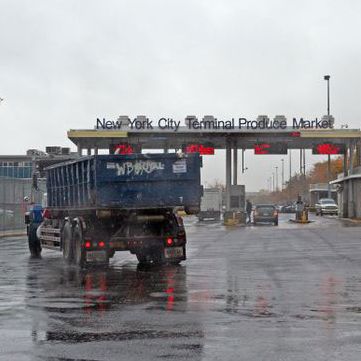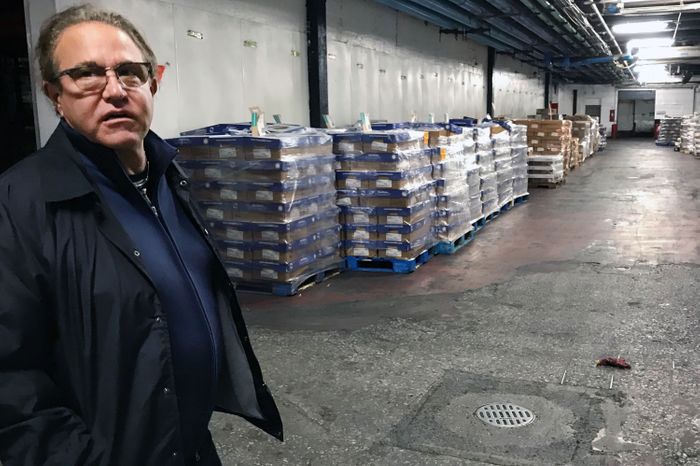
This story was originally published on October 22 by THE CITY.
Seven years after Superstorm Sandy, the de Blasio administration has no plans for coastal flooding defense measures to protect the city’s largest food market — a $3 billion hub that sits on a low-lying peninsula in the Bronx.
The Hunts Point Food Distribution Center — home to 8,500 workers at 115 companies that are anchored by three sprawling markets for meat, produce, and fish — only avoided damage from flooding in October 2012 because the storm surge arrived at low tide, residents and advocates say.
In 2013, officials in the administration of then-Mayor Michael Bloomberg identified an “integrated flood protection system” for Hunts Point among its preferred resiliency projects for the city.
Half a Plan
Years later, city officials have moved forward on just one of the two resiliency projects proposed in 2015 as priorities for Hunts Point by an advisory group of neighborhood residents, business owners and advocates.
The plan underway, part of a federal competition known as Rebuild By Design, dedicates $71 million for food-hub electricity independence, to protect against sustained power outages. It will also bring solar power and energy storage to two nearby public schools, allowing them to serve as emergency shelters.
While residents and advocates support that effort, they say their bigger priority has been coastal flooding protections for an industrial area that distributes food to 22 million residents in the region.
The city Economic Development Corporation’s only gesture on that front has been a verbal commitment to making the vital components of the meat market and two other buildings better able to withstand flood waters — a process called “hardening.” But no funding has been allocated thus far.
“That is absolutely the lowest hanging fruit … and we were just horribly disappointed,” said Annel Hernandez, associate director of NYC Environmental Justice Alliance, which participated in the advisory group sessions. “To date there has been no commitment for an investment toward construction of actual coastal resiliency.”
EDC officials maintain that their work with the community has been collaborative and transparent, and they say the current strategy focusing on energy resiliency and “building hardening” was spurred by available funding, cost-benefit analyses, and community priorities.
“The industrial area and specifically, three buildings in the Hunts Point Food Distribution Center are vulnerable to coastal flooding. Many of the other industrial buildings are already elevated or have loading docks that put critical uses out of the flood plain,” said EDC spokesperson Shavone Williams.
“The city will continue to work with tenants within the FDC as we look at future modernizations and/or redevelopments to identify opportunities to make facilities that face flood risk more resilient and further protect NYC’s food supply.”
The U.S. Department of Housing and Urban Development awarded the city $20 million in June 2014 for a pilot project to improve Hunts Point, in response to a 200-page application that contained not just resiliency proposals, but also a blueprint for revitalizing the waterfront.
The detailed projects proposed by the coalition of public and private groups included electric power safeguards and multiple coastal flooding protections that combined levees, wetland systems, and a waterfront greenway that had long been sought by neighborhood residents.
‘The Easiest and Cheapest Thing’
Of the estimated $1.2 billion price tag, about two-thirds would be dedicated to the flood protections based on findings that significant portions of the food hub sit in the Federal Emergency Management Agency’s 100-year floodplain.
“Because the assets at Hunts Point are critical to regional resilience, a 1% chance of flooding in any given year is considered an unacceptably high risk,” the application for the Rebuild by Design competition said. “As the regional food hub, damage to Hunts Point would result in an immediate and potentially catastrophic disruption of the metropolitan food supply chain.”
In 2015, EDC established an advisory working group to listen to the local community and get input on which of the many project proposals to move to the front of the line. The group, which included neighborhood nonprofits and environmental groups, met throughout the year and settled on two priorities: energy resiliency and flood protection.
In early 2016, EDC hired the consulting group HDR Inc. to conduct feasibility studies on both projects. But because of the limited funding tied to Rebuild By Design — the $20 million from HUD, plus an additional $25 million in federal funding and $26 million in city dollars — only the energy resiliency project was green-lit for completion.
EDC officials said the threat of power outages was a more pressing need for the markets, which depend on refrigeration.
In the summer of 2017, EDC officials presented the five options that had been considered for flood protection: a coastal floodwall, elevating the buildings or just the critical equipment inside them, flood barriers outside the markets, or hardening of the buildings, working group members said.
At a subsequent meeting this summer, they said, EDC officials came back with a decision.
“In terms of flood protection, they just went with the easiest and cheapest thing — which is hardening,” said Maria Torres, president of THE POINT Community Development Corporation, a nonprofit that was involved in all aspects of planning for Hunts Point resiliency.
Feeling Left Out
But as she and others heard about costly coastal protection plans for Red Hook, Brooklyn, and Manhattan’s Lower East Side — which endured significant damage from flooding caused by Sandy — they began to feel left out.
“We do understand they were hit very hard,” said Torres, but “when you talk about equity and waterfront communities, it doesn’t feel equitable.”
EDC and city officials counter that the hardening is sufficient for a nonresidential area that typically would have at least 48 hours to prepare for a major storm event.
They said nonemergency deliveries could be halted, and existing products moved to elevated portions of the market buildings to ride out a storm. In those circumstances, the energy resiliency work — which isn’t scheduled to be completed until March 2022 — would make the biggest impact, they said.
Despite multiple requests, EDC officials refused to provide the evaluations and analyses conducted by HDR that informed the agency’s decision-making. Instead, they referred to PowerPoints containing their own summaries of those findings, which had been shared with the neighborhood working group.
Earlier this year, the de Blasio administration’s revamped resiliency plan for the city — known as OneNYC 2050 — warned of the dire conditions in the decades ahead as a result of climate change.
“Without added protections, much, if not all, of Coney Island, the Rockaway peninsula, Flushing Meadows, Hunts Point, East Harlem, Throgs Neck, and the East Shore of Staten Island could be flooded during storms,” it reads.
Vincent Pacifico, owner of Vista Foods and other firms at the meat market, confirmed that protecting the facility’s power supply was the prime concern. He said that during Sandy, three of the four feeders from Con Edison had been knocked out — causing a near catastrophe.
But he likened the market to an aircraft carrier, because most of the mechanical equipment was housed underneath, in tunnels below ground. He also disputed the notion that companies can simply cancel orders ahead of a major storm, and asked how the remaining stock would be distributed if the plan is to allow the peninsula to flood.
“I hope they understand the gravity of the situation,” said Pacifico. “If it fails here, there’s going to be a ripple effect that’s heart-wrenching for a lot of people in the city.”
This story was originally published by THE CITY, an independent, nonprofit news organization dedicated to hard-hitting reporting that serves the people of New York.






